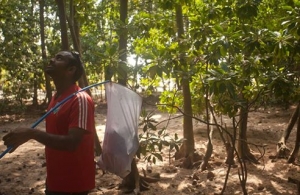Haa Dhaalu Neykurandhoo Island: Kandoo, the propagule or fruit of the small-leafed orange mangrove, was consumed as a staple food. Kandoo could only be collected on Saturdays for two hours after the Island Chief blew the conch. Collection from core areas and sweeping of the forest floor were not allowed, to prevent over-extraction. Some propagules had to be left behind for regrowth.
Laamu Gaadhoo Island: The brackish mangrove area is open for reef fish to lay their eggs. This became useful during “Hulhangu” season, when the seas got rough, as the reef fish from the mangroves could be caught for consumption.
Gaafu Dhaalu Fiyoree Island: At the start of the “Halha” season, there is an inflow of salt water into the wetlands from sea surges. The locals would set up groups to control the inflow of salt water. The excess water collected was let out carefully during two or three nights, with locals staying awake in shifts. Mud was removed by dragging “kashikeyo” (pandanus) crowns. Controlled salinity allowed taro to be cultivated, and draining ensured that excess flood water was let out through this friendly flood control system.

Cultivated taro in a container made from palm fronds. Taro is still widely consumed as a delicacy and is grown in the marshlands © Abdulla Adam.
Noonu Kendhikulhudhoo Island: The mangrove forest is linked to the lagoon during “Halha” season, allowing milkfish (Chanos chanos, known as Bang) to lay their eggs. Mud is removed during this period. Milkfish is caught and eaten as a delicacy to this day.
These are some of the amazing ways in which our past generations engaged with wetlands. However, our lifestyles are changing with the times. People began choosing flour and rice over kandoo. Kulhavaha fruit, though rich in vitamin C, was forgotten in some areas for the imported orange. With gas stoves, firewood no longer had to be extracted. Timber started to be imported for building our homes, and fiber and imported timber started to be used by boat builders.

Three keen explorers wade through the tidal mangrove forest of Baarah. It sure is a site of aesthetic beauty and there is great potential for ecotourism in the mangrove area © Abdulla Adam.
While some changes might have been a necessity with the changing times, we must not forgot the value of our wetlands and mangroves. In fact, there has never been a more important time, as the Maldives fights the adverse effects of climate change.

Koaru, or a brackish mangrove forest in Baarah. A breeding ground and nursery for sharks, sting rays and many other marine creatures. It is also said that the boat used by Muhamadh Thakurfaanu to wage war against the Portuguese to liberate the country used this area as a hiding spot © Abdulla Adam.
That brings us to the theme. Mangrove ecosystems provide many regulatory services in addition to the provisional services listed above. They act as water sinks and help control flooding of our islands during heavy rain and sea surges (udha). The effects of the 2004 tsunami were also felt less in islands that harbor wetlands such as mangroves and marshlands. They help control sedimentation and are in symbiosis with the reef ecosystem, the bedrock on which the existence of Maldivian islands depends. Numerous fish and marine organisms spend a part of their juvenile life in wetlands. The tree roots protect them from large predators. These same tree roots, which are highly adapted and often above the ground, stabilize the soil and act as a barrier to coastal erosion. As mangrove ecosystems act as water sinks and prevent salt water intrusion, they help regulate the ground water lens by helping it replenish and by preventing contamination.
These are all reasons why we should conserve wetland ecosystems.

A mother and daughter wade through the thick Bruguiera cylindrical forests of H. Dh. Neykurandhoo. The mangrove ecosystem is a site of aesthetic beauty and has much potential for eco-tourism © Abdulla Adam.
When we get rid of them we have to invest in artificial structures to replace the services they offer. These structures do not have the natural beauty and aesthetics and do not support the ecological diversity which the wetlands do. They require maintenance, and economic costs are involved in building as well as maintaining them.

Taro fields in the Fiyooaree Marshland area. Goes to show that not all connection with our wetlands has been lost. © Adam Abdulla.
Wetlands, on the other hand, are self-regulating and the diversity and beauty they offer is linked to the identity of Maldivians and our way of life. On this World Wetlands Day, let’s make an attempt to reconnect with these majestic ecosystems. Let’s rebuild our relationships with them, and conserve them by drawing from our forefathers.




